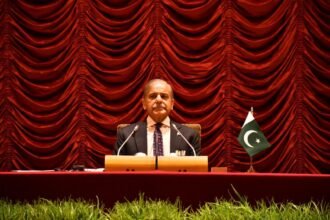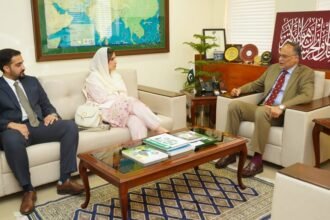Maria Mansab
Pakistan’s economic journey is an inspiring narrative of resilience, adaptability, and determination. Overcoming decades of multifaceted challenges—from external pressures and regional instability to economic setbacks—the nation continues demonstrating a commitment to achieving sustainable and inclusive growth. Despite facing immense adversity, Pakistan has steadily advanced, marking a significant recovery trajectory. For instance, in FY 2024, Pakistan’s per capita GDP stood at $1,680, with FY 2025 projections indicating a rise to $2,405. These figures stand as a testament to the nation’s robust policies and sustained efforts, effectively countering hostile narratives that seek to downplay its progress.
One of Pakistan’s key economic strategies lies in promoting regional equity—a policy that ensures the benefits of growth are distributed across the nation’s diverse regions. Sindh emerges as a standout, boasting a per capita income of $1748. Similarly, Islamabad demonstrates robust performance with a per capita GDP of $2,996, outpacing several regional benchmarks, including India’s national average of $2,106. Other provinces like Punjab, Khyber Pakhtunkhwa (KPK), and Balochistan have shown steady progress, achieving per capita incomes of $1,713.60, $1,388.41, and $1,106, respectively. Furthermore, the northern territories of Gilgit-Baltistan ($1,550) and Azad Jammu and Kashmir ($1,730) underscore the nation’s commitment to fostering balanced development even in remote and historically underserved areas.
Pakistan’s performance is particularly impressive when juxtaposed with its regional neighbor, India. Although India boasts a higher nominal GDP, it struggles with glaring developmental imbalances. Stark inequalities exist between its northern and southern regions, with southern states reporting a per capita income of $3,421 while northern regions—dominated by Hindutva-centric ideologies—languish at just $813. Beyond regional disparities, India faces alarming socio-economic challenges. According to the United Nations Development Program (UNDP) and the Oxford Poverty and Human Development Initiative, India has the dubious distinction of harboring the world’s largest population living below the poverty line, totaling 234 million people.
Unemployment exacerbates these issues, particularly among India’s youth. The International Labour Organization (ILO) reports that youth unemployment among educated individuals surged dramatically, escalating from 35.2% in 2000 to an alarming 65.7% in 2022. These statistics highlight systemic flaws within India’s economic framework, where growth often fails to uplift marginalized communities.
In contrast, Pakistan has prioritized inclusivity and resilience in its economic policies, even while enduring significant external pressures. Over the past two decades, foreign-sponsored terrorism has inflicted a staggering economic cost of over $150 billion, severely hampering investment and growth. Moreover, the nation has carried the humanitarian burden of hosting 4 to 5 million Afghan refugees for decades, placing immense strain on its resources. Despite these adversities, Pakistan’s economic stability and sustained development initiatives underscore its enduring resilience and long-term vision.
The recovery witnessed since 2018 highlights Pakistan’s resilience and adaptability. After experiencing a period of economic stagnation, the nation achieved an all-time high per capita GDP of $1,680 in 2024. This remarkable turnaround can be attributed to targeted reforms addressing structural challenges, fostering economic diversification, and revitalizing key sectors such as agriculture, technology, and trade. The government’s focus on regional equity and improving living standards underscores its commitment to inclusive and sustainable development, setting a precedent for South Asia.
The comparison between Pakistan and India further cements Pakistan’s achievements. India’s economic landscape, marred by stark disparities and socio-economic inequalities, presents a stark contrast to Pakistan’s balanced growth model. While India’s developmental gains are often concentrated and exclusionary, Pakistan’s holistic approach offers valuable lessons for nations grappling with similar challenges. By ensuring that resources are equitably distributed and development is regionally inclusive, Pakistan has emerged as a beacon of hope for addressing inequality and fostering shared prosperity.
Beyond economic performance, Pakistan’s development efforts reflect its resilience in countering negative propaganda. The nation’s focus on fostering growth, particularly in underserved regions, not only counters claims of stagnation but also affirms its commitment to uplifting all segments of society. Federal and provincial coordination has further enhanced resource allocation, allowing initiatives in infrastructure, healthcare, and education to flourish even in remote provinces like Balochistan and KPK. This collaborative approach underscores Pakistan’s dedication to building a unified and prosperous society.
As Pakistan progresses, its achievements serve as a powerful reminder of the nation’s ability to navigate adversity and emerge stronger. Sindh’s economic success, Islamabad’s robust performance, and the resilience demonstrated in regions like Punjab, KPK, and Balochistan highlight a cohesive development model rooted in equity and sustainability. By prioritizing regional integration and addressing socio-economic disparities, Pakistan has solidified its position as a model for balanced growth in South Asia.
Looking ahead, Pakistan’s vision for sustainable and inclusive growth offers a roadmap for transforming challenges into opportunities. Its achievements not only reinforce its standing in the region but also reflect a determined and forward-looking approach to nation-building. With an unwavering focus on equity and resilience, Pakistan continues to inspire hope for a brighter, prosperous, and united future.
The Author is an MPhil scholar from Quaid-e-Azam University.










